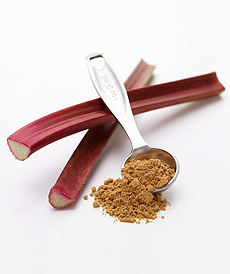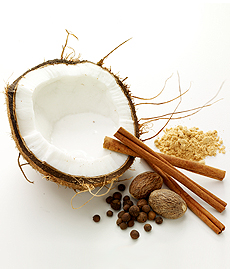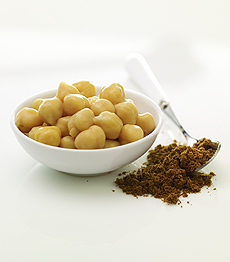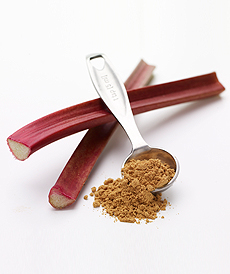
 The unlikely pairing of ginger and rhubarb pair up in a delicious sauce for fish. All photos courtesy McCormick.
The unlikely pairing of ginger and rhubarb pair up in a delicious sauce for fish. All photos courtesy McCormick.
January 2010 |
 |
Flavor Trends 2010: Food Pairings
Page 3: Trends In Food
-
Pumpkin Pie Spice & Coconut Milk
-
Roasted Cumin & Chickpeas
-
Roasted Ginger & Rhubarb
This is Page 3 of a four-page article about trends in food and food pairings, plus ten pages of corresponding recipes. Click on the black links below to view all 10 flavor pairings.
Pairing 6: Pumpkin Pie Spice & Coconut Milk
 Pumpkin pie spice is a blend of dried, powdered spices including cinnamon, cloves, ginger, nutmeg and sometimes allspice. Though it’s typically found in pumpkin, squash and sweet potato pies and other seasonal baking, it can be used year-round to add a burst of flavor to all types of desserts—and even savory dishes, such as sweet potatoes, coffee drinks, cheeseballs or dairy-based dips for salty snacks. Pumpkin pie spice is a blend of dried, powdered spices including cinnamon, cloves, ginger, nutmeg and sometimes allspice. Though it’s typically found in pumpkin, squash and sweet potato pies and other seasonal baking, it can be used year-round to add a burst of flavor to all types of desserts—and even savory dishes, such as sweet potatoes, coffee drinks, cheeseballs or dairy-based dips for salty snacks.
Coconut milk is a sweet, milky-white liquid made from the meat of a mature coconut. It’s created by squeezing grated coconut meat through cheesecloth, and should not be confused with coconut water, which is the naturally occurring foggy liquid found inside coconuts. Coconut milk is widely used in tropical cuisines, especially Indian curries and Thai cuisine (a favorite dish is tom yum, chicken soup with coconut milk).
Recipe: Pumpkin pie spice and coconut milk pair together for a naturally sweet combination in this recipe for Mix & Match Spiced Mousse Mini Desserts. You can also try adding a bit of pumpkin pie spice to tom yum. Here’s a classic tom yum soup recipe (minus the pumpkin pie spice).
 Pairing 7: Roasted Cumin & Chickpeas Pairing 7: Roasted Cumin & Chickpeas
Cumin is a seed that is often confused with caraway, which is actually a fruit. The two spices do look quite similar, but cumin tastes hotter and is lighter in color and larger than caraway seeds. It is one of the most popular spices in the world, and is a highlight in the cuisines of Brazil, Cuba, India, the Middle East, North Africa, Pakistan and Sri Lanka.
Chickpeas (also known as garbanzo beans) are a common foodstuff in many of the same regions as cumin. They make frequent appearances in curries and vegetarian dishes. They’re the base of the popular dip, hummos. Chickpeas also make an excellent snack. They are a most nutritious food, thanks to their high levels of dietary fiber and protein and their low level of fat, most of which is polyunsaturated. (They do have lots of carbs.)
Recipe: Roasted cumin and chickpeas are a globetrotting Mediterranean duet that delivers warm, earthy flavor harmonies. Try them in Shepherd’s Pie with Cumin & Smashed Chickpeas. Try cumin in your next hummos recipe, too.
Pairing 8: Roasted Ginger & Rhubarb
 Ginger is a wonderfully pungent spice with a long history of cultivation. In China, where the plant originated, as well as in other Asian countries, the spice is used in a multitude of both savory and sweet dishes, is eaten raw or pickled and made into candy. In the U.S., ginger is especially associated with holiday baking, thanks to the western tradition of making gingerbread cookies at Christmas. Crystallized ginger is another favorite baking item—as well as a candy. It makes a soothing tea (by itself, with boiling water, or by adding raw slices to your favorite tea). Ginger is high in antioxidants, and as such, is one of the Seven Super Spices. Ginger is a wonderfully pungent spice with a long history of cultivation. In China, where the plant originated, as well as in other Asian countries, the spice is used in a multitude of both savory and sweet dishes, is eaten raw or pickled and made into candy. In the U.S., ginger is especially associated with holiday baking, thanks to the western tradition of making gingerbread cookies at Christmas. Crystallized ginger is another favorite baking item—as well as a candy. It makes a soothing tea (by itself, with boiling water, or by adding raw slices to your favorite tea). Ginger is high in antioxidants, and as such, is one of the Seven Super Spices.
Rhubarb is actually a vegetable, not a fruit. The giveaway might be that it looks like red celery stalks with cabbage-like leafy tops (some can be dark green like spinach or kale). By the time it gets to market, the leaves have been cut off, and we only see the red stalks. (Another giveaway: fruits carry their seeds inside; vegetable seeds scatter in the wind. You see seeds in an apple, avocado, cucumber and tomato, but not in broccoli, carrots or lettuce. Lacking sweetness doesn’t make it a fruit.)
Native to Asia, rhubarb has long been used in Chinese medicine. As anyone knows who has cooked rhubarb, it needs copious amounts of sugar to offset its natural bitterness; thus, its use as a food in the West didn’t come into play until sugar became widely available in the 17th century (sugar cane also originated in Asia). But since then, what a joy! Stewed rhubarb is a delight, as is a rhubarb or strawberry-rhubarb pie or crumble. We make a wicked rhubarb ice cream every summer.
Recipe: Desserts aren’t the only food for which rhubarb is suited. When combined with roasted ginger, you get exciting layers of spicy and sour, with warming notes and a powerful tang. Try them in this recipe for Hot & Sour Tilapia with Gingered Rhubarb Sauce.
Continue To Page 4: Thai Basil & Watermelon, And Others
Go To The Article Index Above
All materials

|







 Ginger is a wonderfully pungent spice with a long history of cultivation. In China, where the plant originated, as well as in other Asian countries, the spice is used in a multitude of both savory and sweet dishes, is eaten raw or pickled and made into candy. In the U.S., ginger is especially associated with holiday baking, thanks to the western tradition of making gingerbread cookies at Christmas. Crystallized ginger is another favorite baking item—as well as a candy. It makes a soothing tea (by itself, with boiling water, or by adding raw slices to your favorite tea). Ginger is high in antioxidants, and as such, is one of the
Ginger is a wonderfully pungent spice with a long history of cultivation. In China, where the plant originated, as well as in other Asian countries, the spice is used in a multitude of both savory and sweet dishes, is eaten raw or pickled and made into candy. In the U.S., ginger is especially associated with holiday baking, thanks to the western tradition of making gingerbread cookies at Christmas. Crystallized ginger is another favorite baking item—as well as a candy. It makes a soothing tea (by itself, with boiling water, or by adding raw slices to your favorite tea). Ginger is high in antioxidants, and as such, is one of the